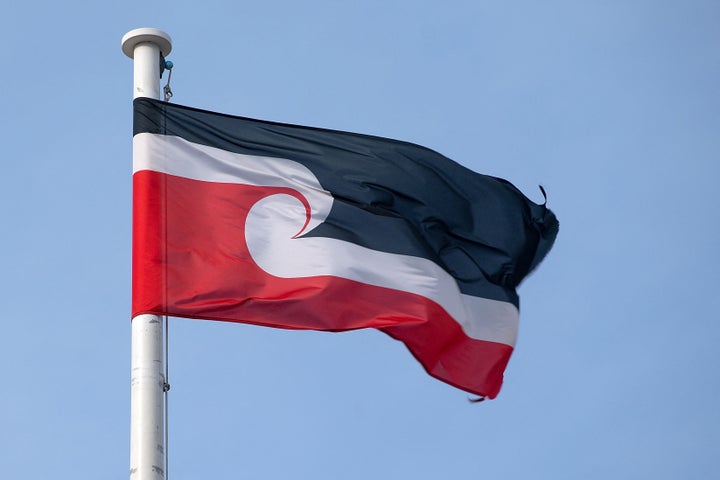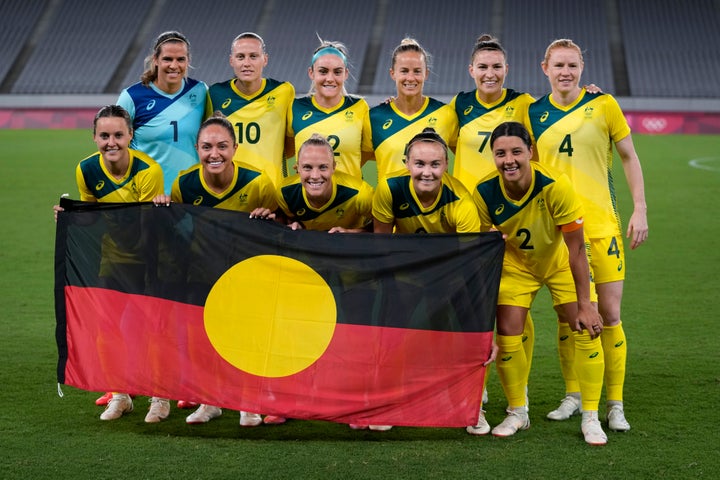Maori, Aboriginal and Torres Strait Islander flags will be prominently displayed throughout the tournament, in a rare departure from FIFA’s strict rules.
For the first time, Indigenous flags are on display alongside the two host nations’ flags at the Women’s World Cup, breaking with FIFA’s typically hard-line game day regulations.
During Thursday’s opening match hosted by New Zealand, the black, white and red Maori flag, known as Tino Rangatiratanga, flew beside the national flag.
In Australia, two flags accompanied the Australian flag: the red, yellow and black Aboriginal flag, and the green, blue and white Torres Strait Islander flag.
FIFA, the international soccer governing body, has strict rules about what type of symbols can be displayed at games and on players’ uniforms. For this tournament, the Aboriginal and Torres Strait Islander flags will be flown at all 35 games played in Australia, and Tino Rangatiratanga will appear at all 29 matches in New Zealand.
“These significant flags express a spirit of mutual respect, national identity, and recognition of Indigenous cultures for our hosts,” FIFA President Gianni Infantino said earlier this month of the decision, which followed a request from soccer governing bodies Football Australia and New Zealand Football that were supported by each country’s government.

The Australian team, the Matildas, includes Noongar woman Lydia Williams and Anaiwan, Biripi and Kamilaroi woman Kyah Simon. The two, joined by teammates, famously posed with the Aboriginal flag before a game at the 2021 Tokyo Olympics.
Williams spoke to the Guardian last month about the importance of increased visibility for Indigenous cultures in Australian sports, particularly for younger generations.
“Hopefully that’s inspired them and made them feel really proud of their culture and who they are,” she told the outlet.

Former athlete Karen Menzies, the first Indigenous person to play for the Matildas when she joined the team in the 1980s, told the Washington Post she felt “pure jubilation” and “enormous pride” seeing the recognition at the World Cup opener this week.
Menzies, now a social work lecturer at the University of Newcastle, served on a cultural advisory panel of six Indigenous women appointed by FIFA last year to “recognize the unique cultures and stories of both countries and ensure they are respected throughout all aspects of next year’s tournament.”
She told the Post the flag was a key issue raised by the panel. “Having the flag represents our voice at this international competition,” Menzies said.
New Zealand Football CEO Andrew Pragnell said flying the Maori flag alongside the country’s national flag was a “powerful symbol,” describing it as an opportunity to shape the tournament’s evolution for future editions to better recognize Indigenous people worldwide.
The opening ceremony in Auckland also paid tribute to Indigenous cultures in both host countries, with ceremonial performances by Maori and First Nations people of Australia.
However, some have accused FIFA of using Indigenous culture for performative purposes without making any meaningful commitment to supporting Maori and First Nations communities.
The Australian Indigenous Football Council wrote a letter to FIFA ahead of the tournament calling for more substantive recognition, such as direct funding and the development of grassroots programs.
Credit: Source link